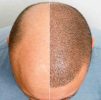
Vitiligo is an autoimmune disease where the body’s immune cells target the cells that produce pigment, or colour, leaving the skin with white patches and occasionally white hairs.
Though vitiligo is a common skin problem, it has recently been normalised, but on the other side, it can impact our self-confidence and make us feel insecure about being different from others. So, what is the solution? In this blog, we will discuss vitiligo, its symptoms, the root cause, various treatment options, and many more.
What changes vitiligo can brought in the skin?
When vitiligo occurs, your skin turns white or appears lighter than it naturally is as a result. Your hair may turn silver or white if you have vitiligo on a hairy area of your body.
Typically, vitiligo begins as a few tiny white macules or patches that may eventually spread throughout your body. Vitiligo usually appears on the areas of hands, feet, and face, but other than that, it can affect any area of the body, which includes the mucous membranes in your eyes, inner ears, mouth area, nose, and genital regions.
Larger patches can occasionally keep growing and spreading, but they typically remain in one location for many years. Because some parts of the skin lose and regain pigment over time, the location of smaller macules varies.
The affected skin varies depending on the individual receiving the vitiligo diagnosis. While some people only have a few areas of depigmentation, others experience a complete loss of skin tone.
If you are wondering what causes vitiligo to appear, then you must know melanocytes are destroyed by your body’s immune system, which results in the condition. Skin cells called melanocytes are responsible for producing melanin, the pigment that gives skin its colour, and when it overproduces, the natural skin colour gets affected, resulting in the occurrence of white patches in certain areas of the body.
Who is more prone to having a skin condition like vitiligo?
All sexes and races are equally affected by vitiligo. Individuals with darker skin tones tend to experience it more. Although macules or patches typically appear before the age of 30, vitiligo can affect anyone at any age.
If you have any of the following autoimmune conditions, you may be more susceptible to developing vitiligo:
- Addison’s illness.
- Anaemia.
- Type 1 diabetes.
- Lupin disease.
- psoriasis.
- The arthritis rheumatoid.
- Thyroid
Are there different types of vitiligo?
Vitiligo is of different types, and to get the right treatment, it is important to know the type of vitiligo you are having.
- Generalized: The most prevalent kind of vitiligo, which results in macules appearing all over your body, is this one.
- Segmental: This kind only affects a single side or body part, like the hands or face.
- Mucosal: Mucosal vitiligo affects the genital and/or oral mucous membranes.
- Focal: Within a year to two years, the macules of a rare type of vitiligo develop in a small area and do not spread in a specific pattern.
- A bullseye with a white or colourless centre, a region with lighter pigmentation, and an area of your natural skin tone are caused by the trichomes.
Let’s understand the root cause of vitiligo.
Vitiligo is a skin condition that is caused by a lack of melanin, a pigment in our skin. One does not know why this occurs. According to research, vitiligo may result from:
- An autoimmune disease is when your body’s defences misinterpret healthy cells, or melanocytes, as foreign invaders, such as bacteria, that could damage your body.
- Genetic issues: The way your melanocytes work may be impacted by a genetic mutation or alteration to your body’s DNA.
- Stress: Regular emotional or physical stress, particularly following an injury, can alter the amount of pigment your melanocyte cells produce.
- Environmental issues: Variables such as UV radiation and exposure to harmful chemicals can alter the function of your melanocyte cells.
Can vitiligo be a health-related concern or cause any complications?
Some common problems that vitiligo can create are as follows:
1. Sensitive skin: As macules and patches do not contain melanocytes, they may be more susceptible to the sun’s rays than the rest of your skin. Instead of tanning, this could quickly burn the skin on your body.
2. Eye abnormalities: Individuals who have vitiligo may have variations in colour in their irises (the coloured portion of the eye) and abnormalities in their retinas (the inner layer of your eye that contains light-sensitive cells). Though the retina, or iris, may occasionally become inflamed, vision is typically unaffected.
3. Predisposition to autoimmune diseases: Individuals who have vitiligo may be at a higher risk of developing other autoimmune diseases that impact the immune system. Anaemia, diabetes, and hypothyroidism are common autoimmune diseases.
4. Emotional difficulties: Vitiligo sufferers may experience shame regarding the appearance of their skin. Some vitiligo patients experience low self-esteem. Someone may experience anxiety or depression as a result, and they may want to withdraw or stay away from social situations.
What is the best and right treatment for vitiligo prescribed by the skin doctor?
The following is a list of some of the top non-surgical vitiligo treatments available:
1. Phototherapy: This procedure is used with a narrow band of ultraviolet B (UVB) light. Phototherapy is helpful in slowing down the progress of active vitiligo. It might work better when taken with corticosteroids or calcineurin inhibitors. It is necessary to attend two or three therapy sessions each week. It may take one to three months before you notice any changes, and it may take up to six months to fully experience the effects.
2. Laser Treatment: The excimer laser creates a UVB beam that is highly concentrated. In this procedure, dermatologists use a wand-like device, also known as an excimer laser, that directs the laser’s beam onto the skin’s lighter spots. It’s probable that the UVB rays will promote skin repigmentation, returning the colour of white areas to their natural state.
The result is shown after several sessions to achieve the desired results. For four to six months, dermatologists may advise twice-weekly sessions. After that, they will determine whether additional treatment is required.
3. Skin Camouflage: There are essentially two kinds of vitiligo camouflage: temporary and permanent.The main technique for attaining long-term concealment is medical tattooing, also known as micropigmentation.
Micropigmenatation is the procedure of implantation of tiny inert pigment granules beneath the skin’s surface. Two to four sessions are usually needed. The process can be finished in less than two hours. Topical anaesthetics are occasionally used to make patients more comfortable during the procedure. The pigment of each patient is blended to resemble their skin tone. Results are immediate, although it takes about three weeks for the full effect to show.
Though we now have various treatment options to treat vitiligo, is there any way to prevent it?
There is no known way to prevent vitiligo because it can have a variety of causes. There are several ways to reduce your chance of vitiligo:
- Avoid sun exposure practices.
- Applying a moisturiser on a daily basis to take care of your skin.
- Preventing physical harm or stress to your body.
- Taking care of any autoimmune diseases that may exist.
What maintenance or self-care do you need to do after vitiligo treatment?
Some maintenance is required following the vitiligo treatment:
- Protect your skin from UV radiation from the sun and artificial sources. Make use of a sunscreen with at least 30 SPF that is broad-spectrum and water-resistant.
- Skin colour differences can be minimised with the use of makeup and self-tanning products. Self-tanning product colour fades gradually over several days rather than washing off.
- Refrain from getting tattoos. After two weeks, a new vitiligo patch may appear due to skin damage, such as that from a tattoo.
Why choose vitiligo treatment at the eEpiderma Clinic?
Vitiligo is an auto-immune disease and requires treatment at the right time. That is why, if you are dealing with the same issue, you are welcome at our clinic.
Our clinic provides treatment with the utmost safety, and we use FDA-approved laser technologies to deliver the best outcomes to our patients. Before the treatment procedure, we schedule a consultation with our patients and our doctor so that the patient can communicate the result they are trying to achieve.
Other than that, we provide various treatment options for vitiligo, and the treatments are executed by examining the patient’s skin condition, and the right treatment is suggested accordingly.









